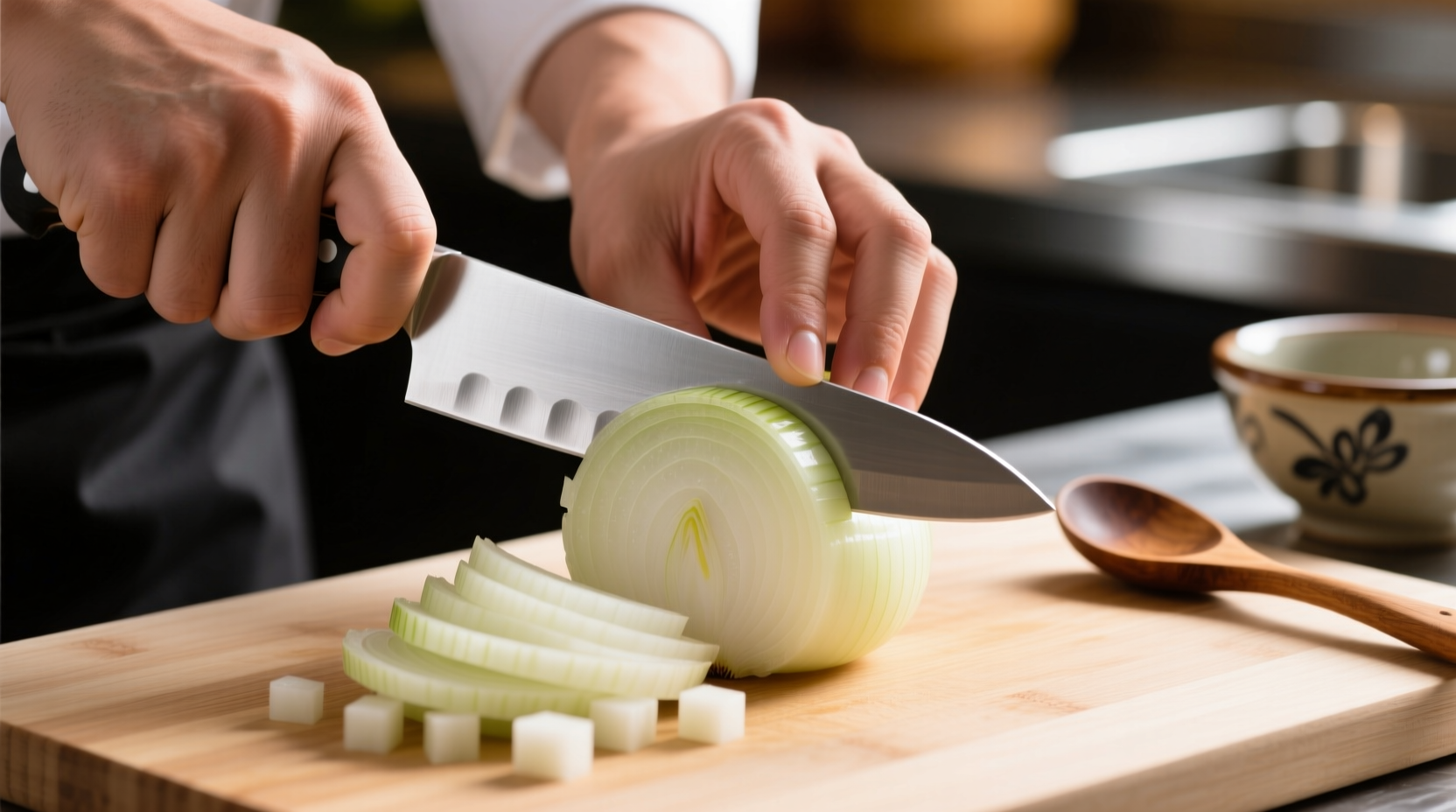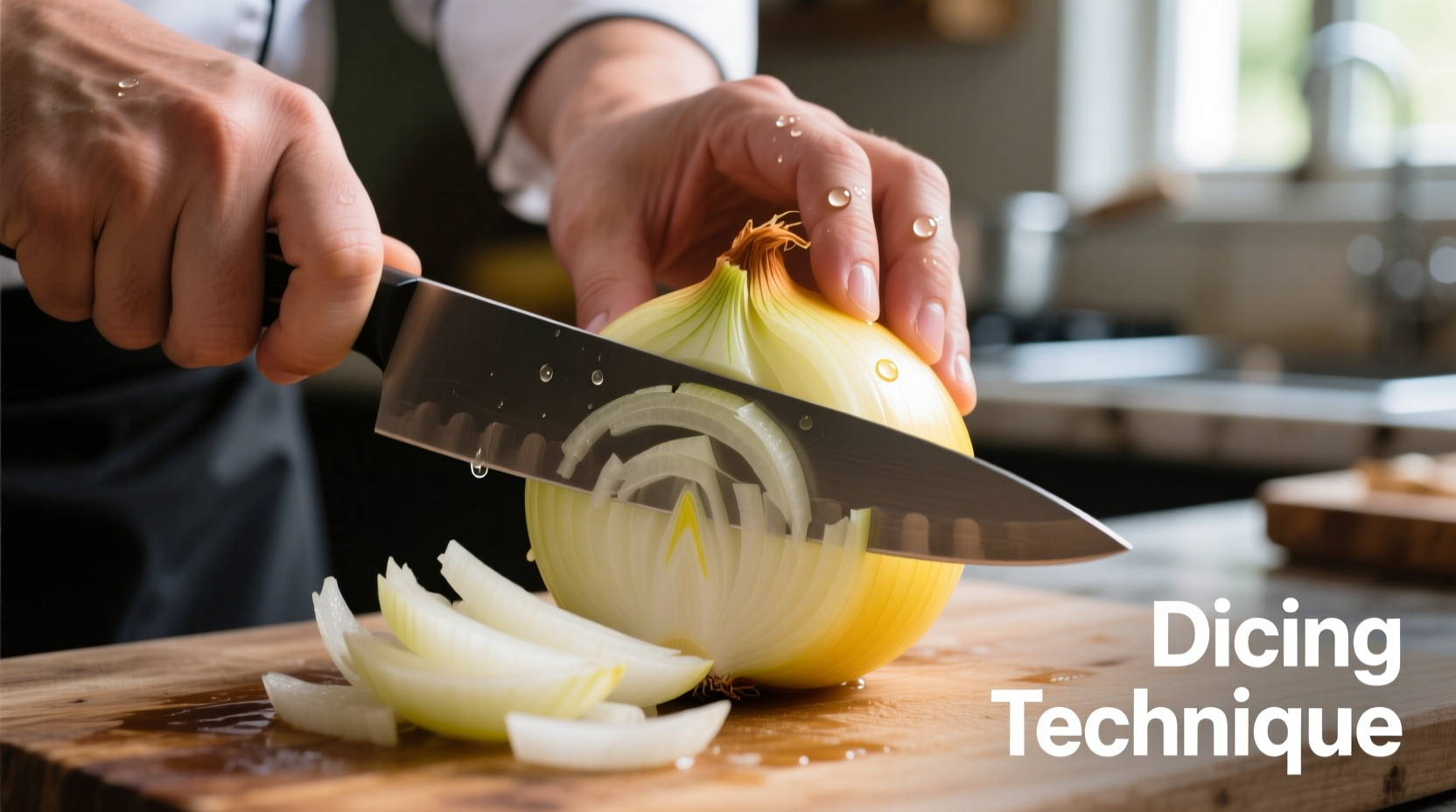Master perfect onion dicing in 7 steps: trim ends, peel, halve pole-to-pole, make horizontal cuts without slicing through root, vertical cuts toward root, then crosswise slices. Use a sharp chef's knife, keep fingertips curled under, and chill onions beforehand to reduce tears. This technique yields uniform 1/4-inch cubes ideal for even cooking in recipes.
The Essential Guide to Dicing Onions Like a Professional Chef
Dicing onions properly transforms your cooking experience. When executed correctly, this fundamental knife skill ensures consistent texture, optimal flavor distribution, and professional results in everything from soups to salsas. Many home cooks struggle with uneven pieces, wasted onion, or the dreaded onion tears—but these challenges disappear with the right technique.
Why Proper Onion Dicing Matters for Your Cooking
Uniformly diced onions cook evenly, preventing some pieces from burning while others remain raw. Professional kitchens maintain strict standards for onion dice size because inconsistent pieces directly impact dish quality. The classic "small dice" (1/4 inch) works perfectly for most applications, while larger dices suit heartier dishes like stews.
| Cut Type | Size | Best Uses |
|---|---|---|
| Small Dice | 1/4 inch | Sauces, salsas, mirepoix |
| Medium Dice | 1/2 inch | Stews, roasts, stir-fries |
| Large Dice | 3/4 inch | Grilled dishes, chunky salsas |
Essential Tools for Perfect Onion Dicing
You don't need specialized equipment, but the right tools make all the difference:
- 8-10 inch chef's knife - Sharpness prevents crushing and reduces tears
- Stable cutting board - Wood or soft plastic prevents slipping
- Bowl for scraps - Keeps workspace organized
According to the Culinary Institute of America's knife skills curriculum, a properly sharpened knife actually reduces onion-induced tears by creating cleaner cuts that release fewer irritants.
Step-by-Step: The 7-Step Onion Dicing Method
- Prepare the onion - Cut off both ends (stem and root), leaving root intact until final steps
- Peel the skin - Remove outer layer and any papery skins
- Halve pole-to-pole - Cut from stem to root through the center
- Make horizontal cuts - Angle knife toward root without cutting through it
- Create vertical slices - Make even cuts toward root end
- Crosswise dicing - Slice perpendicular to previous cuts for uniform cubes
- Final trim - Remove remaining root portion

Science-Backed Strategies to Prevent Onion Tears
Onions release syn-propanethial-S-oxide when cut—a compound that converts to sulfuric acid when contacting eyes. The National Onion Association confirms these effective tear-reduction methods:
- Chill onions for 30 minutes before cutting (reduces volatile compound release)
- Use a sharp knife (minimizes cell damage and irritant release)
- Cut under running water or near a fan (diverts vapors away from face)
- Wear kitchen-safe goggles (creates physical barrier)
Research from the University of California, Davis Department of Food Science shows chilling onions reduces tear-inducing compounds by up to 60% compared to room-temperature onions.
Common Onion Dicing Mistakes and How to Fix Them
Even experienced cooks make these errors that compromise results:
- Mistake: Cutting through the root end too early
Solution: Preserve root structure until final step for better control - Mistake: Inconsistent slice spacing
Solution: Use knuckle as guide for even spacing between cuts - Mistake: Using a dull knife
Solution: Hone before each use and sharpen regularly - Mistake: Rushing the process
Solution: Practice slow, deliberate cuts for safety and precision
When to Choose Different Onion Cuts for Specific Dishes
Understanding context boundaries improves your cooking outcomes. The American Culinary Federation recommends:
- Small dice (1/4 inch) for sauces and fine-textured dishes where uniform cooking is critical
- Medium dice (1/2 inch) for soups and stews needing some texture variation
- Rough chop for stocks where appearance doesn't matter but flavor extraction does
Professional chefs adjust dice size based on cooking time—smaller pieces for quick-cooking dishes, larger for long simmers. This prevents overcooking while ensuring proper flavor development.
Proper Storage of Diced Onions
Store diced onions in airtight containers in the refrigerator for up to 5 days. The USDA Food Safety and Inspection Service recommends:
- Place paper towel in container to absorb excess moisture
- Keep away from strong-smelling foods (onions absorb odors)
- Use glass containers rather than plastic to prevent odor retention
Freezing diced onions works well for cooked applications but changes texture for raw uses. Spread in single layer on baking sheet before transferring to freezer bags to prevent clumping.
Mastering the Foundation of Flavor Building
Perfect onion dicing forms the foundation of countless dishes worldwide. By mastering this fundamental technique, you'll notice immediate improvements in your cooking consistency and flavor development. Remember that practice builds muscle memory—within weeks, this process will become second nature, allowing you to focus on the creative aspects of cooking rather than the mechanics of preparation.











 浙公网安备
33010002000092号
浙公网安备
33010002000092号 浙B2-20120091-4
浙B2-20120091-4